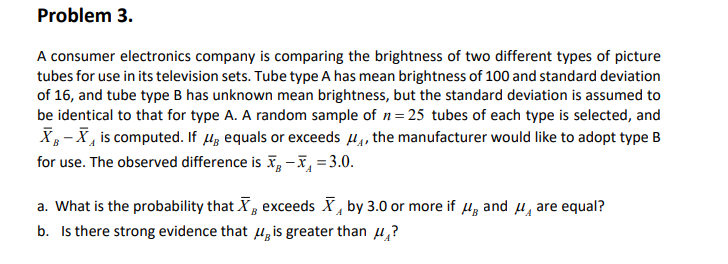A consumer electronics company is comparing the brightness of two different types of picture tubes for use in its television sets. Tube type A has mean brightness of 100 and standard deviation of 16, and tube type B has unknown mean brightness, but the standard deviation is assumed to be identical to that for type A. A random sample of n= 25 tubes of each type is selected, and X , – X , is computed. If Hz equals or exceeds µ„, the manufacturer would like to adopt type B for use. The observed difference is , -I, =3.0. a. What is the probability that X, exceeds X, by 3.0 or more if u, and u, are equal? b. Is there strong evidence that u, is greater than u,?
A consumer electronics company is comparing the brightness of two different types of picture tubes for use in its television sets. Tube type A has mean brightness of 100 and standard deviation of 16, and tube type B has unknown mean brightness, but the standard deviation is assumed to be identical to that for type A. A random sample of n= 25 tubes of each type is selected, and X , – X , is computed. If Hz equals or exceeds µ„, the manufacturer would like to adopt type B for use. The observed difference is , -I, =3.0. a. What is the probability that X, exceeds X, by 3.0 or more if u, and u, are equal? b. Is there strong evidence that u, is greater than u,?
A First Course in Probability (10th Edition)
10th Edition
ISBN:9780134753119
Author:Sheldon Ross
Publisher:Sheldon Ross
Chapter1: Combinatorial Analysis
Section: Chapter Questions
Problem 1.1P: a. How many different 7-place license plates are possible if the first 2 places are for letters and...
Related questions
Topic Video
Question

Transcribed Image Text:Problem 3.
A consumer electronics company is comparing the brightness of two different types of picture
tubes for use in its television sets. Tube type A has mean brightness of 100 and standard deviation
of 16, and tube type B has unknown mean brightness, but the standard deviation is assumed to
be identical to that for type A. A random sample of n= 25 tubes of each type is selected, and
X- X, is computed. If Hz equals or exceeds 4, the manufacturer would like to adopt type B
for use. The observed difference is I, -I, = 3.0.
a. What is the probability that X, exceeds X, by 3.0 or more if µ, and 4, are equal?
b. Is there strong evidence that u, is greater than u,?
Expert Solution
This question has been solved!
Explore an expertly crafted, step-by-step solution for a thorough understanding of key concepts.
This is a popular solution!
Trending now
This is a popular solution!
Step by step
Solved in 2 steps with 1 images

Knowledge Booster
Learn more about
Need a deep-dive on the concept behind this application? Look no further. Learn more about this topic, probability and related others by exploring similar questions and additional content below.Recommended textbooks for you

A First Course in Probability (10th Edition)
Probability
ISBN:
9780134753119
Author:
Sheldon Ross
Publisher:
PEARSON


A First Course in Probability (10th Edition)
Probability
ISBN:
9780134753119
Author:
Sheldon Ross
Publisher:
PEARSON
